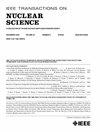基于65nm部分耗尽SOI技术的电压基准电路中总电离剂量诱导的掺杂完全耗尽行为建模
IF 1.9
3区 工程技术
Q3 ENGINEERING, ELECTRICAL & ELECTRONIC
引用次数: 0
摘要
本文演示了65 nm部分耗尽绝缘体上硅(PDSOI)技术的掺杂完全耗尽绝缘体上硅(FDSOI)行为,以实时了解电压基准(VR)进行剂量沉积时的输出电压位移。从深入的自上而下的分析,包括实验和技术计算机辅助设计(TCAD)/模拟程序与集成电路重点(SPICE)模拟,我们强调了这种意想不到的掺杂FDSOI行为。这项研究表明,由于前后界面之间的耦合效应,它如何恶化总电离剂量(TID)效应,这在该技术中是不常见的。建立了考虑通道掺杂和TID的阈值电压模型,表明掺杂浓度是一个重要的硬化参数。该模型在多尺度方法中被重用,以再现基于PDSOI晶体管退化的VR的输出电压移。本文章由计算机程序翻译,如有差异,请以英文原文为准。
Modeling of Doped Fully Depleted Behavior Induced by Total Ionizing Dose in Voltage Reference Circuits From a 65-nm Partially Depleted SOI Technology
In this article, a doped fully depleted silicon on insulator (FDSOI) behavior for the 65-nm partially depleted silicon on insulator (PDSOI) technology is demonstrated to understand the output voltage shift of a voltage reference (VR) undergoing dose deposition in real time. From an in-depth top-bottom analysis, including both experiments and technology computer aided design (TCAD)/simulation program with integrated circuit emphasis (SPICE) simulations, we highlighted this unexpected doped FDSOI behavior. This study shows how it worsens the total ionizing dose (TID) effects due to the coupling effect between the front and back interfaces, not usual in this technology. A new threshold voltage model considering channel doping and TID is developed, showing how doping concentration is an important hardening parameter. This model is reused, in a multiscale approach, to reproduce the output voltage shift of a VR based on the PDSOI transistor degradation.
求助全文
通过发布文献求助,成功后即可免费获取论文全文。
去求助
来源期刊

IEEE Transactions on Nuclear Science
工程技术-工程:电子与电气
CiteScore
3.70
自引率
27.80%
发文量
314
审稿时长
6.2 months
期刊介绍:
The IEEE Transactions on Nuclear Science is a publication of the IEEE Nuclear and Plasma Sciences Society. It is viewed as the primary source of technical information in many of the areas it covers. As judged by JCR impact factor, TNS consistently ranks in the top five journals in the category of Nuclear Science & Technology. It has one of the higher immediacy indices, indicating that the information it publishes is viewed as timely, and has a relatively long citation half-life, indicating that the published information also is viewed as valuable for a number of years.
The IEEE Transactions on Nuclear Science is published bimonthly. Its scope includes all aspects of the theory and application of nuclear science and engineering. It focuses on instrumentation for the detection and measurement of ionizing radiation; particle accelerators and their controls; nuclear medicine and its application; effects of radiation on materials, components, and systems; reactor instrumentation and controls; and measurement of radiation in space.
 求助内容:
求助内容: 应助结果提醒方式:
应助结果提醒方式:


